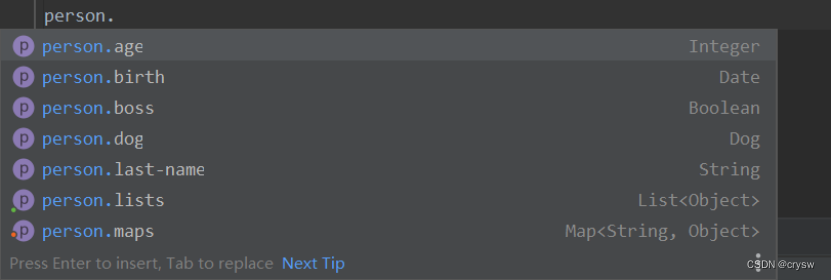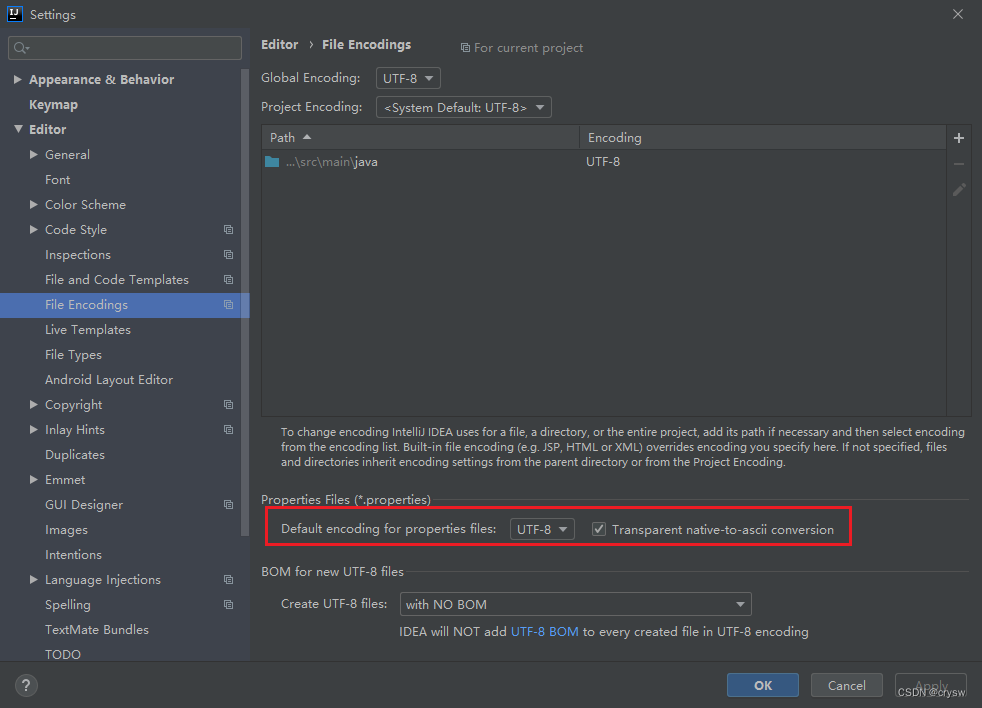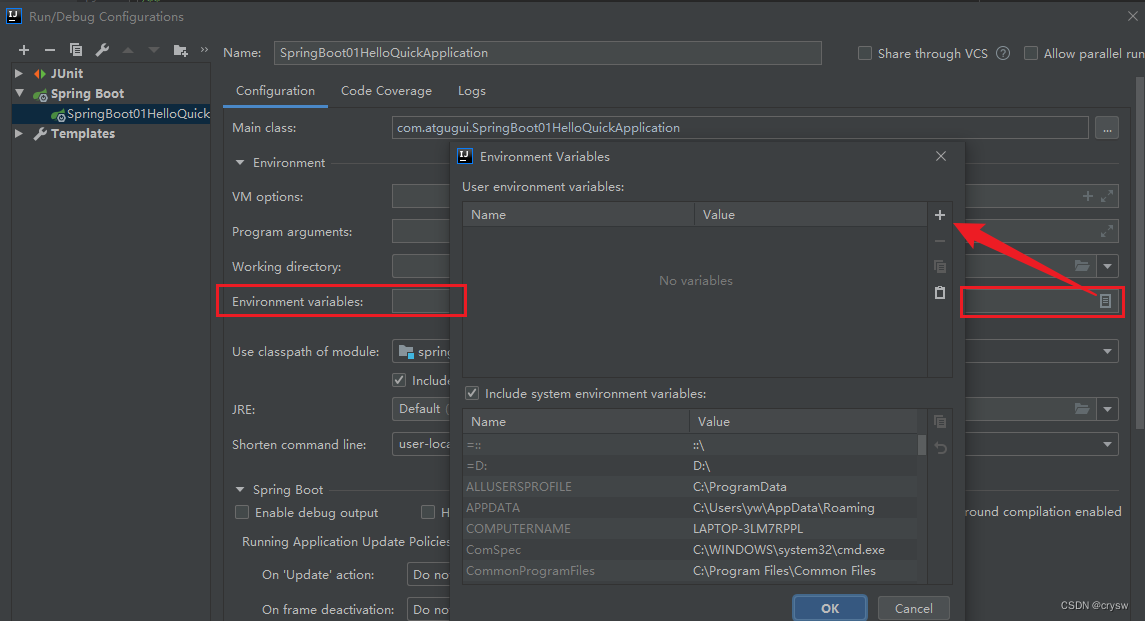Chapter2 : SpringBoot配置
尚硅谷SpringBoot顶尖教程
1. 全局配置文件
SpringBoot使用一个全局的配置文件 application.properties 或者 application.yml ,该配置文件放在src/main/resources目录或者类路径/config目录下面, 可以用来修改SpringBoot自动配置的默认值。
yml是YAML(YAML Ain’t Markup Language)语言的文件,参考规范http://www.yaml.org/
以前的配置文件, 大多都是使用xml文件, 比较繁重; yml则以数据为中心, 比json,xml更适合做配置文件。
2. yaml语法
2.1 基本语法
key: (空格) value 表示一对键值对儿(空格必须有)
以空格的缩进来控制层级关系;只要是左对齐的一列数据,都是同一个层级。属性和值是大小写敏感的。
server:
port: 8084
2.2 值的写法
字面量: 普通的值(数字,布尔值,字符串)。字符串不用加单引号或者双引号。
双引号:不会转义字符串里面的特殊字符,特殊字符会作为本身意义表示。
name: "zhangsan \n lisi"
输出:
zhangsan
lisi
单引号:会转义特殊字符,特殊字符最终只是一个普通的字符串数据。
name: 'zhangsan \n lisi'
输出:
zhangsan \n lisi
对象、Map(属性和值)
对象还是key: value的形式。在下一行来写对象的属性和值,注意缩进。例如对象friends:
friends:
lastName: zhangsan
age: 20
对象还有行内写法:
friends: {lastName: zhangsan, age: 18}
数组(List、Set)
用-值表示数组中的一个元素
animals:
- cat
- dog
- pig
数组也有行内写法:
animals: [cat,dog,pig]
3. 配置文件值注入
3.1 @ ConfigurationProperties注入
配置文件配置内容如下:
person:
age: 18
boss: false
birth: 2017/12/12
maps: {k1: v1,k2: v2}
lists:
- lisi
- wanwu
dog:
name: 旺财
age: 2
last-name: zhangsan
JavaBean, 注意Person类要写setXXX()方法才会注入成功。
@Component
@ConfigurationProperties(prefix = "person") // 优先级高于@value
public class Person implements Serializable {
private String lastName;
private Integer age;
private Boolean boss;
private Date birth;
private Map<String, Object> maps;
private List<Object> lists;
private Dog dog;
// getXXX setXXX
}
我们可以导入配置文件处理器,以后编写配置就有提示。
<dependency>
<groupId>org.springframework.boot</groupId>
<artifactId>spring-boot-configuration-processor</artifactId>
<optional>true</optional>
</dependency>
yml书写效果:

properties文件书写效果:

测试结果:
Person{lastName='zhangsan', age=18, boss=false, birth=Tue Dec 12 00:00:00 CST 2017, maps={k1=v1, k2=v2}, lists=[lisi, wanwu, cat]], dog=Dog{name='旺财', age=2}}
3.2 中文乱码问题
yml或properties配置文件的参数配置为中文值,注入出现乱码问题。

修改系统默认配置文件的编码

3.3 @Value注入
JavaBean
@Component
public class Person implements Serializable {
@Value("${person.last-name}")
private String lastName;
@Value("#{10*2}")
private Integer age;
@Value("true")
private Boolean boss;
private Date birth;
// @Value不支持复杂类型
// @Value("${person.maps}")
private Map<String, Object> maps;
private List<Object> lists;
private Dog dog;
// getXXX setXXX
}
测试结果:
Person{lastName='zhangsan', age=20, boss=true, birth=null, maps=null, lists=null, dog=null}
@ ConfigurationProperties优先级高于@Value
3.4 @ ConfigurationProperties结合@PropertySource
如果不想将person属性配置在全局配置文件(properties或yaml)中, 可以放到自定义的properties文件中。
自定义person.properties文件
person.last-name=张胜男${random.uuid}
person.age=${random.int}
person.birth=2017/12/15
person.boss=false
person.maps.k1=v1
person.maps.k2=v2
person.lists=[pig,dog,cat]
person.dog.name=旺财-${person.last-name}-${person.hello:hello}
person.dog.age=2
在JavaBean类上使用@PropertySource引入自定义的properties文件。
@Component
@PropertySource(value = {"classpath:person.properties"})
@ConfigurationProperties(prefix = "person") // 优先级高于@value
public class Person implements Serializable {
private String lastName;
private Integer age;
private Boolean boss;
private Date birth;
private Map<String, Object> maps;
private List<Object> lists;
private Dog dog;
// getXXX setXXX
}
测试结果:
Person{lastName='张胜男6eea5415-7d81-41a1-95be-bf72dba5b839', age=-298203675, boss=false, birth=Fri Dec 15 00:00:00 CST 2017, maps={k1=v1, k2=v2}, lists=[[pig, dog, cat]], dog=Dog{name='旺财-张胜男c650e5a0-791f-4f39-9d4f-1bea2d7527bf-hello', age=2}}
3.5 @ ConfigurationProperties结合@Bean
@ ConfigurationProperties结合@Bean可以为属性赋值 。
JavaBean
public class Dog {
private String name;
private Integer age;
// getXXX , setXXX
}
在全局配置文件yaml中配置dog对象的属性值。
dog:
name: 旺财
age: 2
在主启动类或配置类中使用@ ConfigurationProperties结合@Bean声明dog实例并给属性赋值。
@Bean
@ConfigurationProperties(prefix = "dog")
public Dog dog() {
return new Dog();
}
测试结果:
Dog{name='旺财', age=2}
3.6 JSR303校验
@ConfigurationProperties结合@Validated注解支持JSR303进行配置文件属性值的校验。
pom.xml文件中需要加入相关依赖,尤其是验证依赖的实现类。
<dependency>
<groupId>javax.validation</groupId>
<artifactId>validation-api</artifactId>
</dependency>
<dependency>
<groupId>org.hibernate</groupId>
<artifactId>hibernate-validator</artifactId>
<version>5.2.4.Final</version>
</dependency>
JavaBean
package com.atgugui.bean;
import org.springframework.validation.annotation.Validated;
// ....省略导入
@Component
@ConfigurationProperties(prefix = "person") // 优先级高于@value
@Validated
public class Person implements Serializable {
@Null // lastName必须为空
private String lastName;
private Integer age;
private Boolean boss;
private Date birth;
private Map<String, Object> maps;
private List<Object> lists;
private Dog dog;
// getXXX setXXX
}
启动应用报错,测试结果:
Property: person.lastName
Value: 张胜男562391e3-b84a-4d4d-ad9e-3d0322d67e94
Reason: 必须为null
3.7 @Value和@ ConfigurationProperties比较
| 功能 | 批量注入配置文件中的属性 | 一个个指定 |
| 松散绑定(松散语法) | 支持 | 不支持 |
| SpEL | 不支持 | 支持 |
| JSR303数据校验 | 支持 | 不支持 |
| 复杂类型封装 | 支持 | 不支持 |
如果我们只是在某个业务逻辑中需要获取一下配置文件中的某项值,就用@Value
4. @ImportResource
读取外部配置文件,导入Spring的配置文件,让配置文件里面的内容生效。在对SSM老项目进行架构升级时可以在配置类中使用该注解将原来xml配置中的Bean维护到IOC容器中,实现与SpringBoot兼容的效果。
编写xml配置 beans.xml
<?xml version="1.0" encoding="UTF-8"?>
<beans xmlns="http://www.springframework.org/schema/beans"
xmlns:xsi="http://www.w3.org/2001/XMLSchema-instance"
xsi:schemaLocation="http://www.springframework.org/schema/beans
http://www.springframework.org/schema/beans/spring-beans.xsd">
<bean id="helloServiceBean" class="com.atgugui.service.HelloServiceBean"/>
</beans>
编写test测试模拟:
@SpringBootTest
@RunWith(SpringRunner.class)
class SpringBoot01HelloQuickApplicationTests {
@Autowired
ApplicationContext ioc;
@Test
public void testHelloService() {
boolean helloServiceBean = ioc.containsBean("helloServiceBean");
System.out.println(MessageFormat.format("contains helloServiceBean: {0}", helloServiceBean));
}
}
没使用@ImportResouce注解的测试结果:
contains helloServiceBean: false
SpringBoot里面没有Spring的xml配置文件,我们自己编写的xml配置文件也不能自动识别。想让Spring的xml配置文件加载生效,使用@ImportResource注解。可以在主启动类添加 @ImportResource注解,指定要加载的xml配置。
@SpringBootApplication
@ImportResource(locations = {"classpath:beans.xml"})
public class SpringBoot01HelloQuickApplication {
public static void main(String[] args) {
SpringApplication.run(SpringBoot01HelloQuickApplication.class, args);
}
}
使用@ImportResouce注解的测试结果:
contains helloServiceBean: true
当然,SpringBoot推荐使用JavaConfig配置类的方式给容器中添加组件,不编写xml配置。
不需要编写xml配置,改用配置类实现Spring配置文件:
@Configuration
public class MyAppConfig {
// 将方法的返回值添加到容器中,容器中这个组件默认的id就是方法名
@Bean
public HelloServiceBean helloServiceBean() {
System.out.println("配置类@Bean给容器中添加HelloServiceBean组件");
return new HelloServiceBean();
}
}
测试结果:
配置类@Bean给容器中添加HelloServiceBean组件
contains helloServiceBean: true
5. 配置文件占位符
5.1 随机数
RandomValuePropertySource 配置文件中可以使用随机数。

5.2 属性配置占位符
- 可以在配置文件中引用前面配置过的属性。
- ${person.hello:默认值} 来指定找不到属性时的默认值。
编写占位符配置:
person.last-name=张胜男${random.uuid}
person.age=${random.int}
person.dog.name=旺财-${person.last-name}-${person.hello:hello}
打印person测试结果:
Person{lastName='张胜男80eae444-2550-442c-b657-f5f6704794a3', age=1952295864, boss=false, birth=Fri Dec 15 00:00:00 CST 2017, maps={k1=v1, k2=v2}, lists=[[pig, dog, cat]],
// 读取到上面的person.last-name ${person.hello}没有就使用指定的默认值hello
dog=Dog{name='旺财-张胜男91918168-7841-41ce-9359-7129d6a866cd-hello', age=2}}
6. Profile
6.1 多profile文件形式
格式:application-{profile}.properties
application-dev.properties , application-prod.properties
然后在默认配置文件application.properties中指定加载哪个环境的配置文件:
#指定加载dev环境配置
spring.profiles.active=dev
#指定加载prod环境配置
#spring.profiles.active=prod
6.2 yml支持多profile文档块形式
使用三个短横线分割多个profile文档块,然后通过spring.profiles.active=${profile}指定加载哪个环境的配置。
spring:
profiles:
active: prod
---
server:
port: 8081
spring:
profiles: dev
---
server:
port: 8084
spring:
profiles: prod
6.3 profile激活方式
可以在全局配置文件中指定: spring.profiles.active=dev
也可以在在命令行指定: --spring.profiles.active=dev
如果执行jar包也可以指定环境配置: java -jar xxx.jar --spring.profiles.active=dev

jvm参数指定配置环境 : -Dspring.profiles.active=dev

系统环境变量也可以指定

7. 配置文件加载位置
Spring Boot启动会扫描以下位置的application.properties或者application.yml文件作为SpringBoot的默认配置文件。
-
file:./config/
-
file:./
-
classpath:/config/
-
classpath:/
以上都是按照优先级从高到低的顺序,所有位置的文件都会被加载,高优先级配置内容会覆盖低优先级配置内容。SpringBoot会从这四个位置全部加载主配置文件,互补配置。我们也可以通过配置spring.config.location来改变默认配置。
java -jar xxx.jar --spring.config.location=D:\\application.properties
8. 外部配置加载顺序
SpringBoot支持多种外部配置方式,可以从以下位置加载配置。优先级从高到低,高优先级的配置会覆盖低优先级的配置,所有的配置会形成互补配置。
- 命令行参数, 多个参数配置用空格分开:
java -jar xxx.jar --server.port=8082 --server.context-path=/abc
- 来自java:comp/env的JNDI属性
- Java系统属性(System.getProperties())
- 操作系统环境变量
由jar包外向jar包内寻找,优先加载带profile的配置
-
jar包外部的application-{profile}.properties或application-{profile}.yml(带spring.profile)配置文件。
-
jar包内部的application-{profile}.properties或application-{profile}.yml(带spring.profile)配置文件。
-
jar包外部的application-{profile}.properties或application-{profile}.yml(不带spring.profile)配置文件。
-
jar包内部的application-{profile}.properties或application-{profile}.yml(不带spring.profile)配置文件。
-
@Configuration注解类上的@PropertySource
-
通过SpringApplication.setDefaultProperties指定的默认属性。
参考官方资料: https://docs.spring.io/spring-boot/docs/1.5.9.RELEASE/reference/htmlsingle/#boot-features-external-config
9. 自动配置原理
9.1 剖析源码
-
SpringBoot启动的时候加载主配置类,开启了自动配置功能 @EnableAutoConfiguration
-
@EnableAutoConfiguration作用:
利用AutoConfigurationImportSelector给容器导入一些组件。
可以导入selectImport()方法的内容,通过下面的方法获取候选的配置。AutoConfigurationImportSelector#selectImports
@Override public String[] selectImports(AnnotationMetadata annotationMetadata) { if (!isEnabled(annotationMetadata)) { return NO_IMPORTS; } try { // ... // 获取候选的配置 List<String> configurations = getCandidateConfigurations(annotationMetadata, attributes); // .... } catch (IOException ex) { throw new IllegalStateException(ex); } }AutoConfigurationImportSelector#getCandidateConfigurations
protected List<String> getCandidateConfigurations(AnnotationMetadata metadata, AnnotationAttributes attributes) { // SpringFactoriesLoader加载META-INF/spring.factories文件配置 List<String> configurations = SpringFactoriesLoader.loadFactoryNames( // getSpringFactoriesLoaderFactoryClass()=EnableAutoConfiguration.class getSpringFactoriesLoaderFactoryClass(), getBeanClassLoader()); Assert.notEmpty(configurations, "No auto configuration classes found in META-INF/spring.factories. If you " + "are using a custom packaging, make sure that file is correct."); return configurations; }AutoConfigurationImportSelector#getSpringFactoriesLoaderFactoryClass
protected Class<?> getSpringFactoriesLoaderFactoryClass() { return EnableAutoConfiguration.class; }SpringFactoriesLoader#loadFactoryNames(…) 扫描所有jar包类路径下META-INF/spring.factories,把扫描到的这些文件内容包装成Properties对象。
从properties中获取
EnableAutoConfiguration.class类对应的值,然后把它们加载到容器中。将类路径下META-INF/spring.factories里面配置的所有
EnableAutoConfiguration.class类对应的值加入到容器中。public static List<String> loadFactoryNames(Class<?> factoryClass, ClassLoader classLoader) { // EnableAutoConfiguration.class.getName()=EnableAutoConfiguration String factoryClassName = factoryClass.getName(); try { // FACTORIES_RESOURCE_LOCATION = "META-INF/spring.factories" Enumeration<URL> urls = (classLoader != null ? classLoader.getResources(FACTORIES_RESOURCE_LOCATION) : ClassLoader.getSystemResources(FACTORIES_RESOURCE_LOCATION)); // 存放解析后的候选配置 List<String> result = new ArrayList<String>(); while (urls.hasMoreElements()) { URL url = urls.nextElement(); // 将解析的组件封装到properties对象中 Properties properties = PropertiesLoaderUtils.loadProperties(new UrlResource(url)); String factoryClassNames = properties.getProperty(factoryClassName); result.addAll(Arrays.asList(StringUtils.commaDelimitedListToStringArray(factoryClassNames))); } return result; } catch (IOException ex) { throw new IllegalArgumentException("Unable to load [" + factoryClass.getName() + "] factories from location [" + FACTORIES_RESOURCE_LOCATION + "]", ex); } }下图中每一个这样的xxxAutoConfiguration类都是容器中的一个组件,都加入到容器中进行自动配置。

9.2 案例分析
以HttpEncodingAutoConfiguration为例解释自动配置原理
// 表示这是一个配置类,相当于以前的xml配置
@Configuration
// 启动指定配置类的属性配置绑定
@EnableConfigurationProperties(HttpEncodingProperties.class)
// Spring底层@Conditional注解根据不同的条件, 以及是否满足指定的条件来控制整个配置类里面的配置是否生效
@ConditionalOnWebApplication // 判断当前应用是否是web应用, 如果是web应用则生效
// 判断当前项目有没有指定的类, 如果有则生效
@ConditionalOnClass(CharacterEncodingFilter.class) // SpringMVC中解决乱码问题的过滤器
// 判断配置文件中是否存在某个配置属性,matchIfMissing=true 如果判断不存在默认也成立并生效
@ConditionalOnProperty(prefix = "spring.http.encoding", value = "enabled", matchIfMissing = true)
public class HttpEncodingAutoConfiguration {
// 与SpringBoot项目的全局配置文件application.properties建立映射关系
private final HttpEncodingProperties properties;
// 只有一个有参构造器时, 参数的属性值就会从容器中获取
public HttpEncodingAutoConfiguration(HttpEncodingProperties properties) {
this.properties = properties;
}
@Bean
// 给容器中添加一个组件,该组件的某些属性值要从this.properties中获取
@ConditionalOnMissingBean(CharacterEncodingFilter.class)
public CharacterEncodingFilter characterEncodingFilter() {
CharacterEncodingFilter filter = new OrderedCharacterEncodingFilter();
filter.setEncoding(this.properties.getCharset().name());
filter.setForceRequestEncoding(this.properties.shouldForce(Type.REQUEST));
filter.setForceResponseEncoding(this.properties.shouldForce(Type.RESPONSE));
return filter;
}
// ....
}
以上根据当前不同的条件判断,决定这个配置类是否生效。一旦这个配置类生效,这个配置类就会给容器中添加各种组件,这些组件的属性从对应的properties类中获取的,这些类里面的每一个属性又是和配置文件绑定的。
所有在配置文件中能配置的属性是在xxxProperties类中封装着,配置文件能配置什么就可以参照某个功能对应的这个属性类。
#我们能配置的属性都是来源于这个功能的properties类
spring.http.encoding.enabled=true
spring.http.encoding.charset=utf-8
spring.http.encoding.force=true
将SpringBoot项目全局配置文件中spring.http.encoding前缀的属性值绑定并填充到HttpEncodingProperties中.
实现属性值的绑定读取需要在启动类或配置类上添加@EnableConfigurationProperties注解开启属性绑定配置。
@ConfigurationProperties(prefix = "spring.http.encoding")
public class HttpEncodingProperties {
//...
}
9.3 Conditional派生注解
@Conditional派生注解(Spring注解版原生的@Conditional作用):
必须是@Conditional指定的条件成立,才给容器中添加组件,配置里面的所有内容才会生效。
| @Conditional扩展注解 | 作用(判断是否满足当前指定条件) |
|---|---|
| @ConditionalOnJava | 系统的java版本是否符合要求 |
| @ConditionalOnBean | 容器中存在指定Bean; |
| @ConditionalOnMissingBean | 容器中不存在指定Bean; |
| @ConditionalOnExpression | 满足SpEL表达式指定 |
| @ConditionalOnClass | 系统中有指定的类 |
| @ConditionalOnMissingClass | 系统中没有指定的类 |
| @ConditionalOnSingleCandidate | 容器中只有一个指定的Bean,或者这个Bean是首选Bean |
| @ConditionalOnProperty | 系统中指定的属性是否有指定的值 |
| @ConditionalOnResource | 类路径下是否存在指定资源文件 |
| @ConditionalOnWebApplication | 当前是web环境 |
| @ConditionalOnNotWebApplication | 当前不是web环境 |
| @ConditionalOnJndi | JNDI存在指定项 |
自动配置类必须在一定的条件下才能生效。我们如何知道哪些自动配置类生效。可以通过在全局配置文件application.properties文件中配置SpringBoot的debug模式,来让控制台打印自动配置报告,从而查看哪些自动配置类生效。
#开启SpringBoot的debug模式
debug=true
查看SpringBoot项目启动日志:
匹配上且生效的自动配置类
Positive matches:
-----------------
DispatcherServletAutoConfiguration matched:
- @ConditionalOnClass found required class 'org.springframework.web.servlet.DispatcherServlet'; @ConditionalOnMissingClass did not find unwanted class (OnClassCondition)
- @ConditionalOnWebApplication (required) found StandardServletEnvironment (OnWebApplicationCondition)
DispatcherServletAutoConfiguration.DispatcherServletConfiguration matched:
- @ConditionalOnClass found required class 'javax.servlet.ServletRegistration'; @ConditionalOnMissingClass did not find unwanted class (OnClassCondition)
- Default DispatcherServlet did not find dispatcher servlet beans (DispatcherServletAutoConfiguration.DefaultDispatcherServletCondition)
// ........
没有生效的自动配置类
Negative matches:
-----------------
ActiveMQAutoConfiguration:
Did not match:
- @ConditionalOnClass did not find required classes 'javax.jms.ConnectionFactory', 'org.apache.activemq.ActiveMQConnectionFactory' (OnClassCondition)
AopAutoConfiguration:
Did not match:
- @ConditionalOnClass did not find required classes 'org.aspectj.lang.annotation.Aspect', 'org.aspectj.lang.reflect.Advice' (OnClassCondition)
// ..............
2023-03-12 20:45:19.142 INFO 21220 --- [ main] c.a.SpringBoot01HelloQuickApplication : Started SpringBoot01HelloQuickApplication in 2.672 seconds (JVM running for 4.087)
